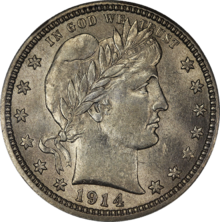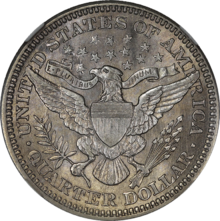Barber silver quarters were minted between 1892 and 1916.
The obverse design of the Barber Quarter features a right facing head of Lady Liberty. Upon her head is a pileus, a crown fashioned from olive branches. She also wears a small headband with the word “Liberty” inscribed.

The phrase “In God We Trust” is inscribed above Lady Liberty on the coin’s obverse face. The outer edge of the obverse shows 13 six-pointed stars as well as the year of minting.

The reverse design highlights the heraldic eagle design that is based on the Great Seal of the United States. The eagle’s mouth holds a scroll inscribed “E Pluribus Unum”. Its right claws hold an olive branch; its left claw holds 13 arrows. Above the eagle are 13 five-pointed stars. The outer edge of the reverse is surrounded by the name of the country and by the coin’s denomination.
When sold as junk silver, Barber quarters often show signs of heavy wear from circulation. Many examples found in junk silver will have a partial or missing date. Some may have fairly smooth obverse and reverse faces showing little detail and lots of signs of circulation wear.
It is common for online bullion dealers to sell Barber Silver Quarters in standard bank rolls. A standard bank roll of Barber Quarters contain 40 coins with a Face Value of $10.
Each $10 Face Value roll of Silver Barber Quarters contains roughly 7.15 troy ounces of silver.
There are many key dates and mint marks of Barber Silver Quarters that may have numismatic value even in poor circulated condition.
As junk silver, Barber quarters may carry a slight premium over Washington Quarters.